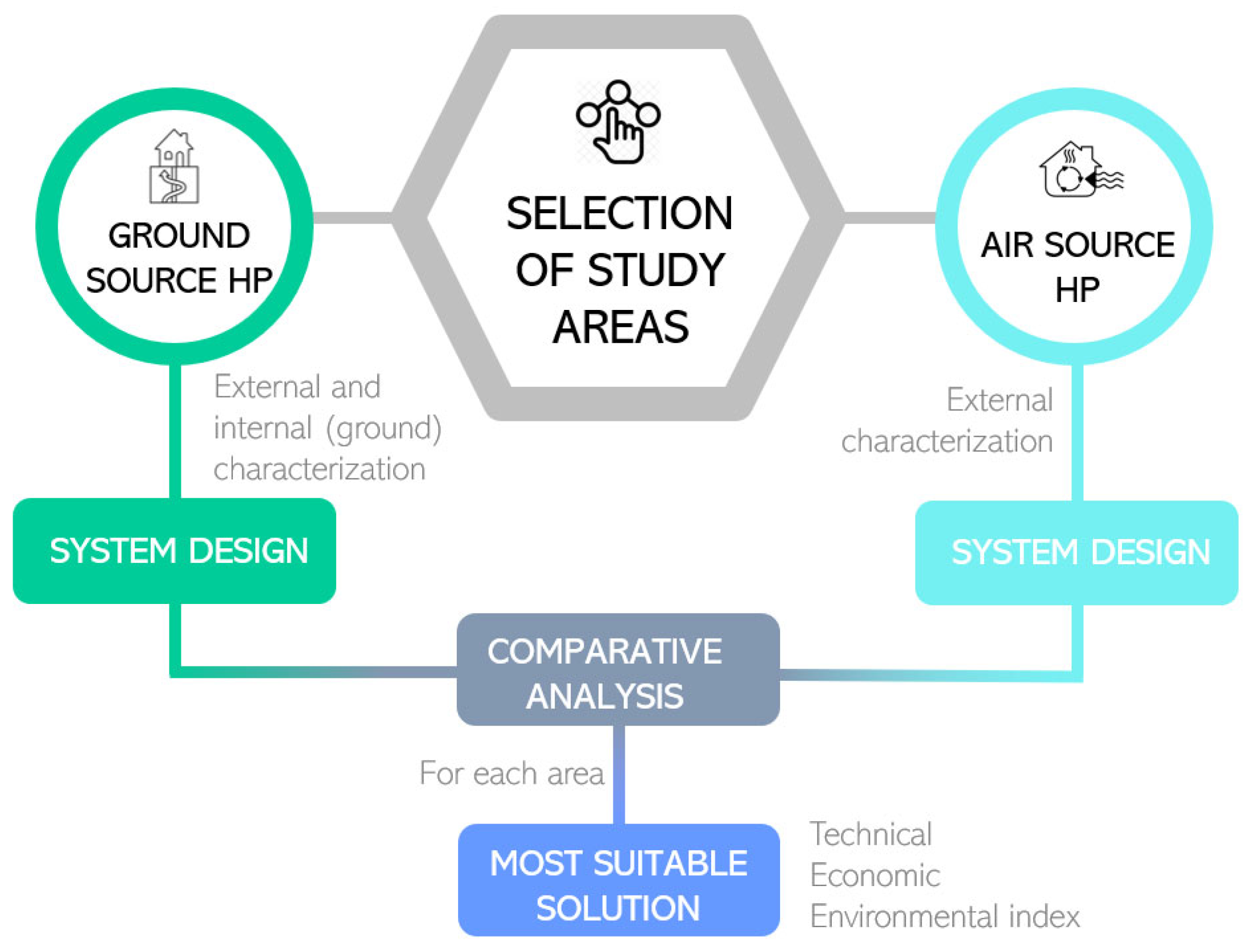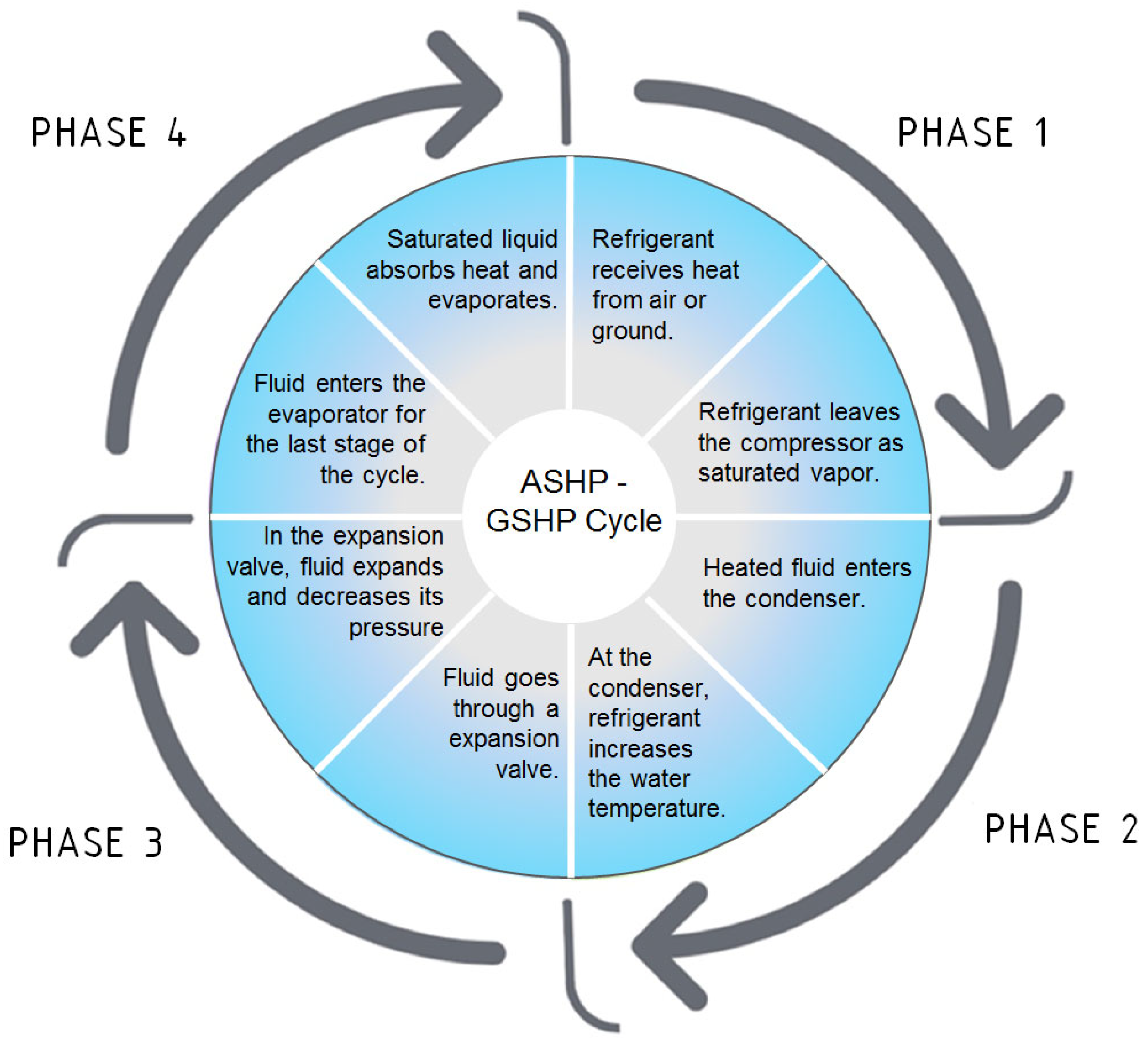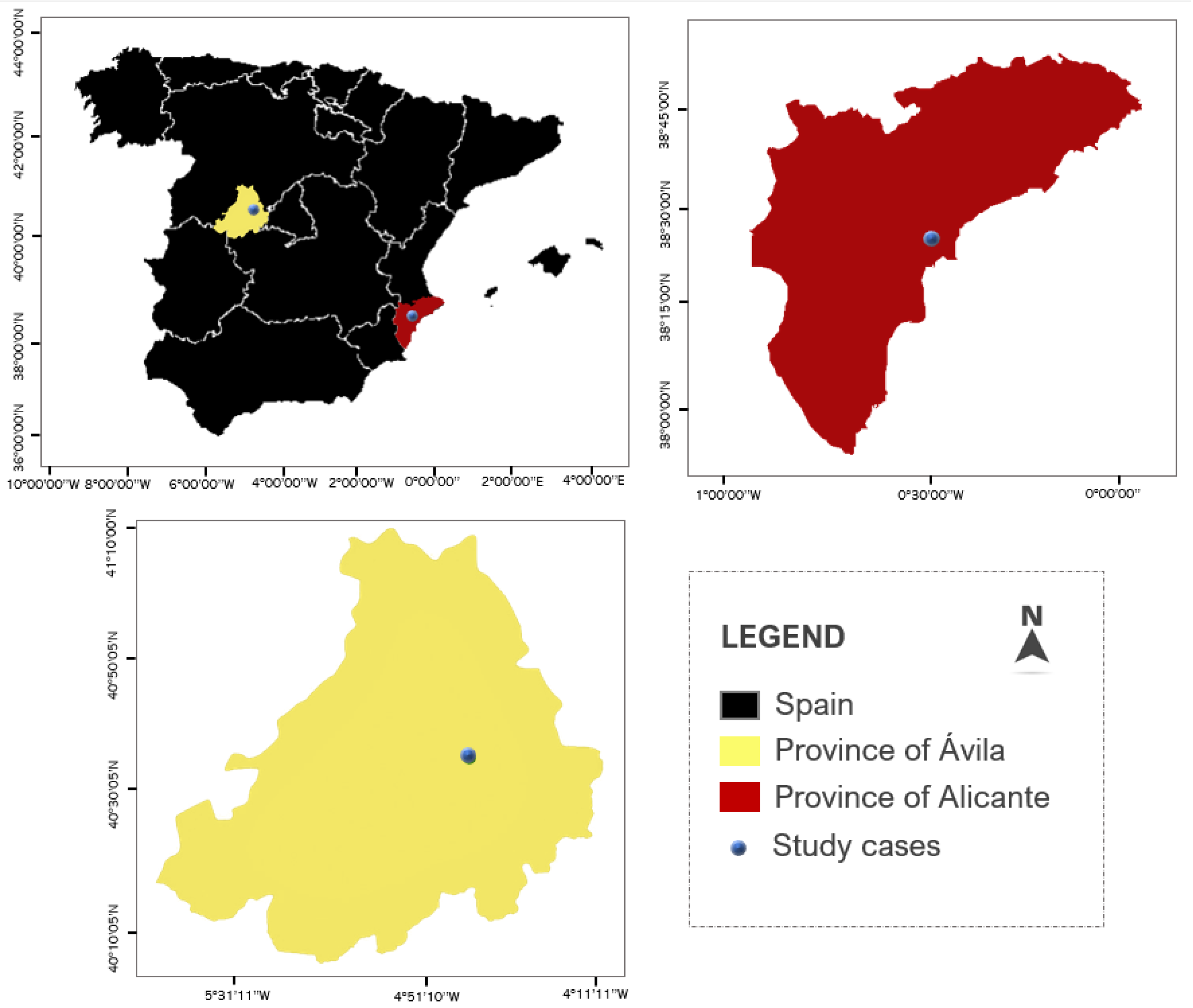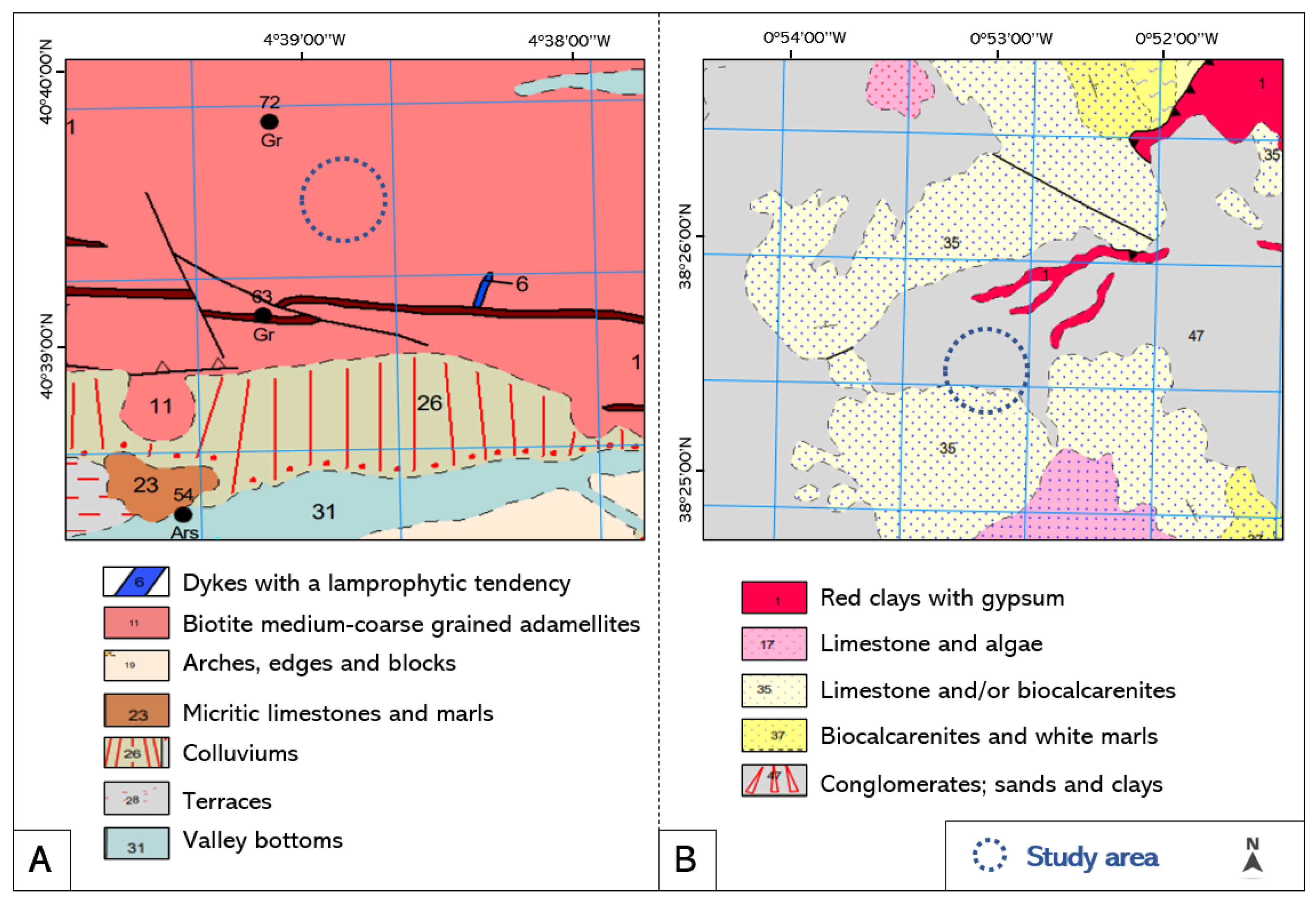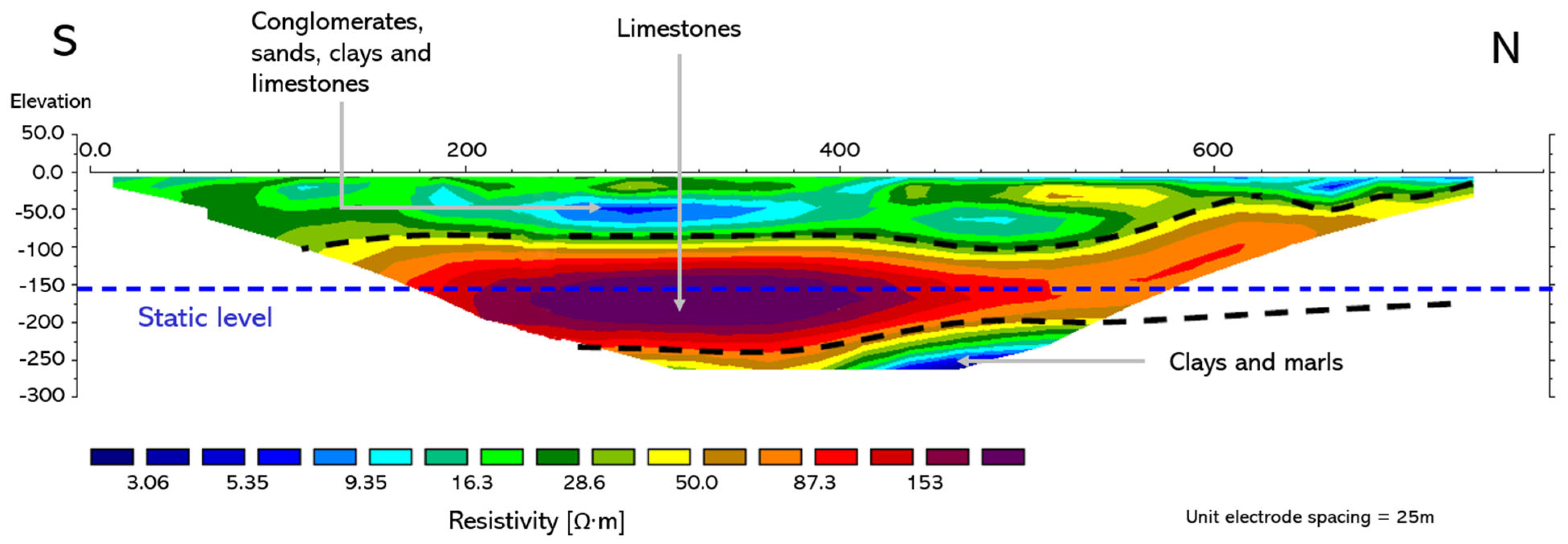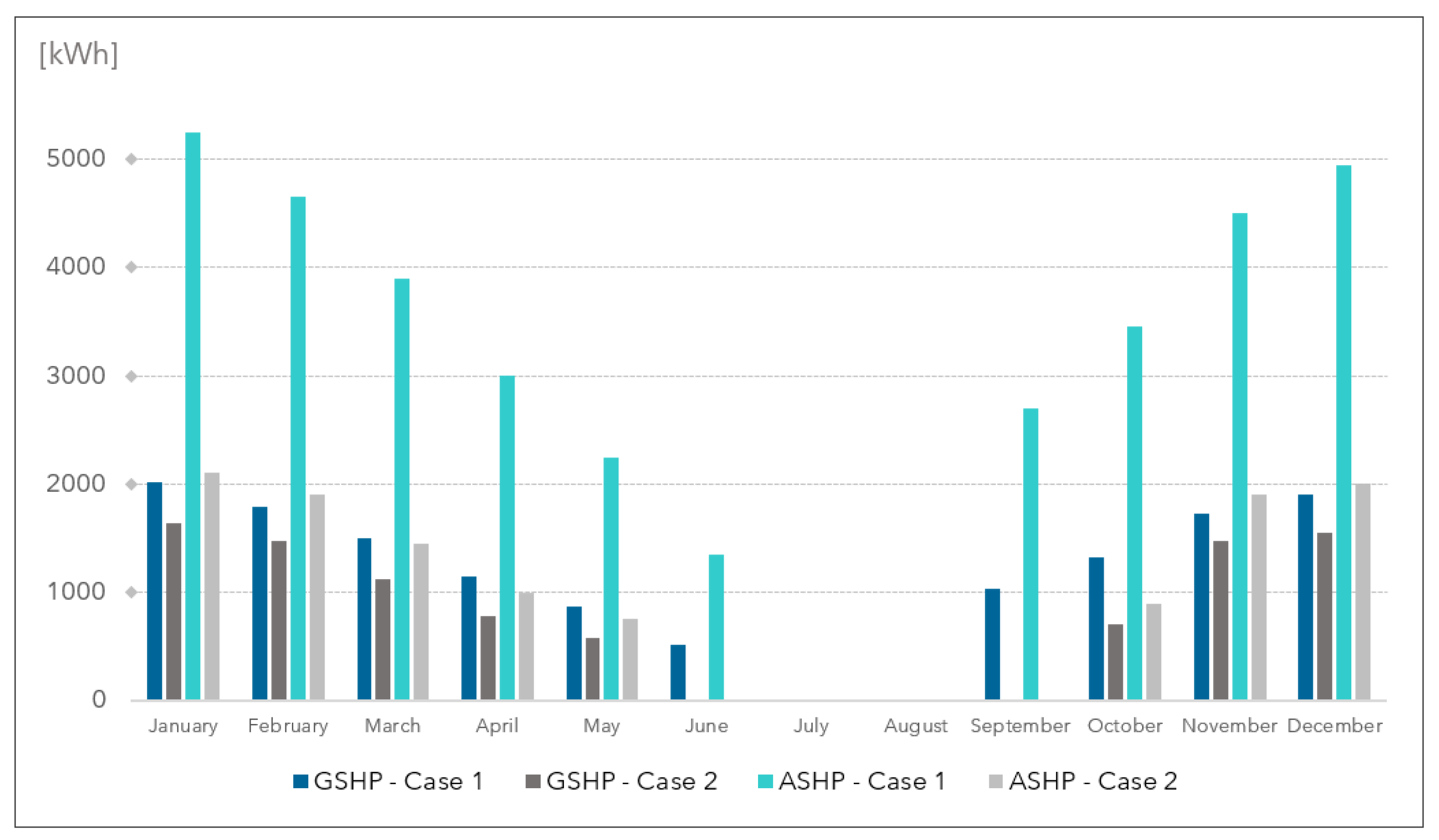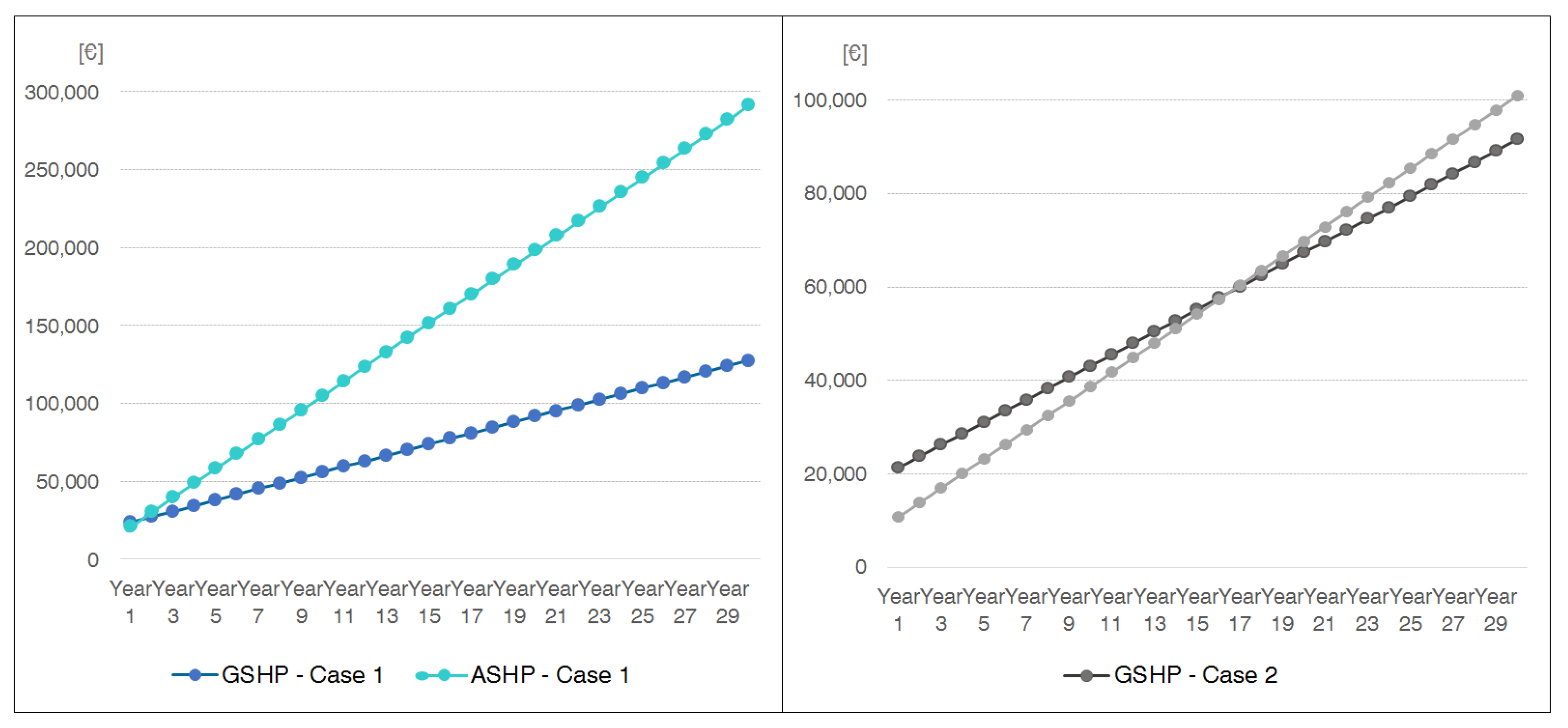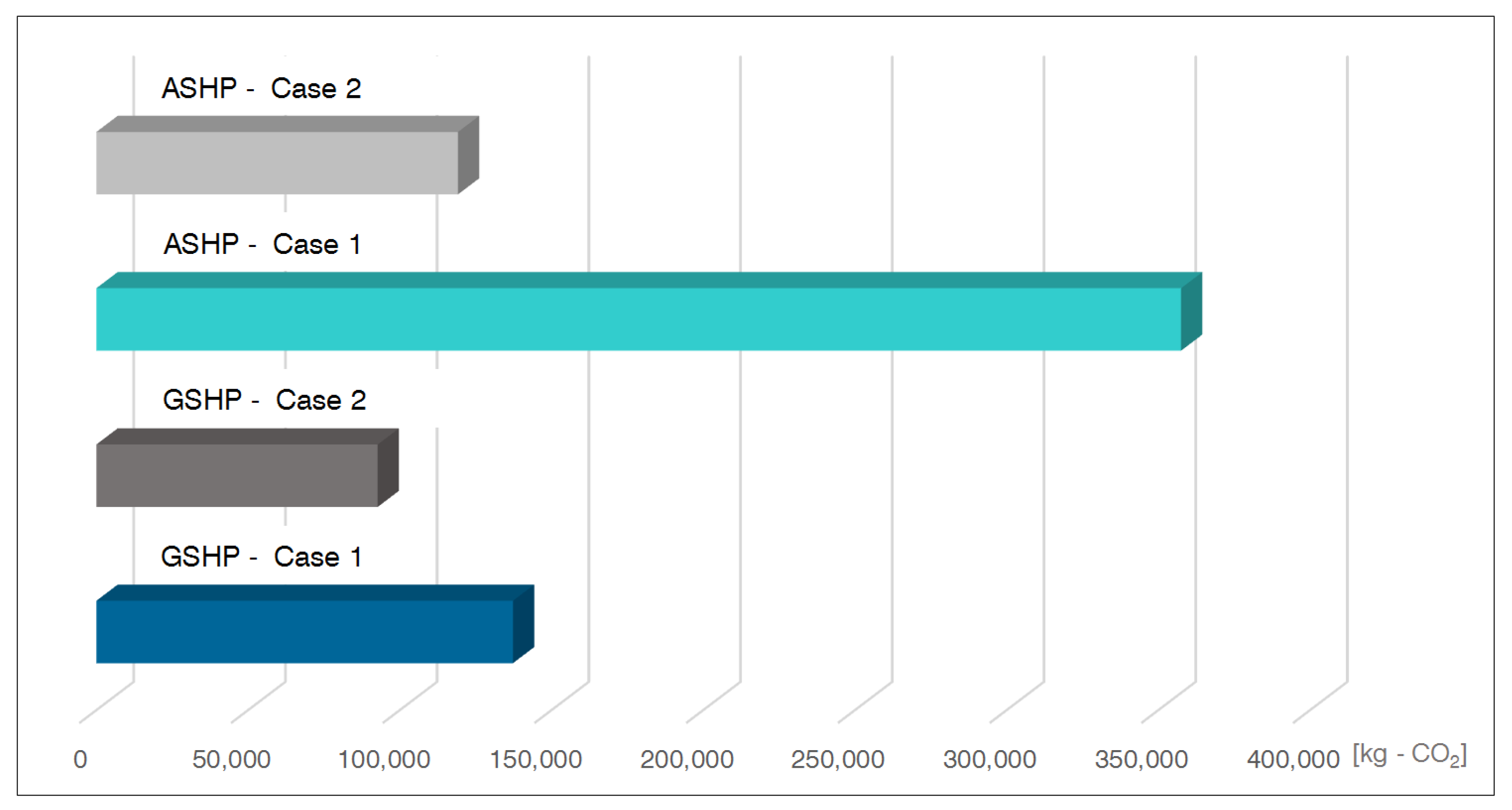1. Introduction
Economic growth, directly linked to world population growth, is one of the main causes of the global energy consumption increase [
1]. In this scenario, the world energy supply is still alarmingly dependent on the use of fossil fuels, which inevitably translates into unacceptable emissions of Green House Gases (GHG) [
2]. With the final aim of mitigating the devastating effects of these traditional energy sources, renewable energies arise as a significant mechanism for coping with climate change. In this way, wind, solar or hydroelectric power systems (usually the most used) are frequently incorporated by states as renewable solutions to reduce the vulnerability of electricity systems and fossil fuels dependence [
3].
Focusing on heating and cooling energy applications, in Europe the building sector is responsible for 40% of the energy consumption and 36% of CO
2 emissions; however, the housing sector is the key for reducing global GHG emissions with a saving potential up to 90% by 2050 [
4]. In this context, the implementation of renewable energies for reducing these emissions is considered inherent to achieving European objectives [
5].
For the above, beyond the commented renewable technologies, geothermal energy is slowly increasing in the European context, constituting a feasible option to assist in reaching the Paris Agreement to limit the atmospheric temperature increase 2 °C or less [
6], and the objectives of the Roadmap 2050 to control the GHG emissions by 20% below 1990 levels by 2020 and by 80–95% by 2050 [
7]. In this sense, the European Union funded with a total of 90 million euros the development of geothermal technologies during the period of 2014–2018 within the Horizon 2020 Framework Program [
8]. Other additional European policies support the development of renewable heating and cooling solutions with great expectations for shallow geothermal energy. Furthermore, the new Horizon Europe Framework Program conceived for 2021–2027 strongly focuses on the mitigation of climate change in which shallow geothermal resources play a significant role [
9].
As deduced from the above, over the last few years, a special focus has been set on the mentioned shallow geothermal energy, exploited by Ground Source Heat Pumps (GSHP) for moving forward the decarbonization of the residential sector. Despite this fact, and the high potential of this energy, only around 2% of renewable heating and cooling is produced in Europe through these systems [
10]. The reasons of this low geothermal use are mainly due to non-technological barriers, such as upfront costs, legal issues, or low visibility and awareness for end users [
11]. In this regard, different actions are required to face all these issues, from regional and national measures but also through novel research aimed at optimizing this potential but still not spread enough solution [
12,
13,
14,
15].
Derived from the previous barriers, especially the investment that is initially required in most of the GSHP building installations, Air Source Heat Pumps (ASHP) are increasingly growing in the heating and cooling sector, becoming the most common form of heat pumps in Europe [
16]. These devices will probably play an important role as building heating is electrified, especially in urban areas. However, ASHP systems are not always the most advantageous alternative, meaning a non-recommended solution in those scenarios in which the external conditions cause high operating costs.
1.1. Heat Pumps Overview
As mentioned above, heat pumps have become one of the most influential technologies in future sustainable energy development. These devices are capable of transferring heat from a natural environment such as the ground, air, or water, as well as from other sources of industrial or domestic waste. They move heat from a region of low temperature to another of higher temperature (or inverted) by using a small amount of electricity, being used for both space cooling and heating and for water heating as Domestic Hot Water (DHW).
Heat pump efficiency is defined by the comparison of the amount of heat energy provided by the heat pump and the amount of energy that it consumes, which is in turn expressed as the Coefficient Of Performance (COP), the ratio of the amount of heating/cooling in kilowatts delivered by a heat pump, Q, to the kilowatts of power consumed by the heat pump, W. Analogously, in the cooling mode, the Energy Efficiency Ratio (
EER) is used to express the relation between the heat extracted from the space and the electricity consumed by the heat pump. In fact, one of the main advantages attributed to these systems is the high COP and, therefore, the reduced electrical consumption associated with their use. The value of this COP depends on the conditions of the installation, but it is especially high in GSHP systems and in those hybridizations of heat pumps (both GSHP and ASHP) with other renewable systems, such as solar collectors or photovoltaic panels [
17,
18].
1.1.1. Geothermal Heat Pumps
Geothermal heat pumps or ground source heat pumps exploit the Earth’s heat through heat exchangers buried in the ground. This makes it possible to increase heat extraction but at the same time makes the global heating system more expensive and disruptive. Two main categories are found in these solutions, the water-to-air (most used in office buildings) system, which uses water for the thermal exchange with the ground and air for heating the space and the water-to-water (especially used in the residential sector) alternative that applies water for both purposes. Within the global geothermal systems, two different configurations are frequently found; open-loop systems (also including surface-water heat pumps), which extract water directly from a nearby aquifer or river through an extraction well and return it after passing through the installation through a second injection well. In turn, there are closed-loop exchange systems that are based on the use of a sealed exchanger that extracts heat from a rocky or soil underground source. These pipes can be arranged horizontally, at depths of 1–2 m, although the most common schema is the use of vertical boreholes with depths between 100–150 m, which significantly increase the thermal exchange with the ground due to their capability to exploit the thermal resource at a constant temperature during the whole year and the higher temperature values achieved at those levels.
The heating capacity of these systems is directly related to the size of the buried thermal exchangers, so it is vital to perform a correct sizing of the system to avoid thermal comfort loss during the progressive operation of the installation [
19]. In this sense, it is especially important to perform an in-depth study of the subsoil for defining the predominant geological formations in depth and their capacity for thermal exchange with the components of the geothermal system [
20,
21].
1.1.2. Air Source Heat Pumps
Air source heat pump systems are based on using the difference between the indoor and outdoor air temperatures to heat/cool a certain space. These devices are commonly divided into two main varieties: air-to-air and air-to-water systems.
The first category directly heats the air of a room by the use of a wall-mounted box (different indoor units can be connected to the compressor as multi-split systems, to increase the number of rooms to be heated). As the GSHPs, most of these systems are reversible units, performing both heating and cooling.
On the other hand, air-to-water heat pumps are integrated into a hydronic central heating system that aims at providing the building heating and hot water. Beyond the outdoor compressor, split systems also need a control unit and a compact heat exchanger placed next to the hot-water cylinder to transfer heat from the refrigerant.
ASHPs are the most widely used heat pumps and are present in numerous countries, being often preferred in moderate climates and in those existing houses located in high-density urban areas with the limited surrounding land. Air-to-air heating alternatives are widely distributed across southern Europe and Asia, where the climate conditions allow their use for both heating and air conditioning [
22,
23,
24,
25].
Reviewed literature attributes GSHPs with several advantages in terms of higher energy efficiency, lower life cycle cost and less impact on the environment, all coupled with greater system reliability and other practical reasons. In short, GSHP systems are recommended in those cases of new construction buildings, with high energy demands and where the user can face high or moderate initial investments. GSHPs are also considered a priority in climates with great seasonal temperature variation. Regarding ASHPs, these are suited when the local climate is mild, when the land availability does not allow the earth connection or when the user prioritizes shorter payback periods [
26,
27]. However, most of these statements are variable in function on the specific case under study and in particular, the climate conditions where the space is located [
28,
29].
Another aspect to consider is the Urban Heat Island (UHI) effect and its relation with the use of both GSHP and ASHP systems. Published research highlights the role of these solutions to remove the accumulated heat from urban area and the significant mitigation of this phenomenon when they are implemented. Results also declare a net superiority of the GSHP compared to the ASHP, especially in heating mode when open geothermal loops are used on existing aquifers [
30]. In the case of ASHP technologies, it is well known that they contribute to alleviating the urban heat island effect (heat is absorbed from the outdoor air at the same time that cold exhaust is emitted), showing substantial cooling effects that achieve to decrease the air temperatures of the site when different heat pumps are operating in cooling mode [
31].
Despite the general rules previously mentioned, it is still a reality that in numerous cases the user does not have the necessary information to determine what type of heat pump is the most appropriate for the particular characteristics of the installation to be heated. Since most of the existing research has focused on the analysis of heating and cooling in industrial energy systems, there is a clear lack of precise information in this regard adapted to the domestic sector. For the above, this research intends to evaluate the most suitable heat pump alternative in different scenarios and climatic zones. The objective is to provide new information on the performance of each system under different conditions and to contribute to future decision-making that, in turn, helps to decarbonize the energy system in an optimized way adjusted to the needs of the assumption. The main novelty of the work is the inclusion of real data of the study areas, based on in situ prospecting tests, that allow characterizing in detail the conditions of the locations to better predict the behavior of both GSHP and ASHP systems and perform an improved and justified decision. The structure of the paper is as follows:
Section 2 includes the description of the methodology and cases under study,
Section 3 presents the main results of the work and, finally,
Section 4 and
Section 5 address the discussion and conclusions extracted from it.
2. Methodology
As mentioned in the introductory section, this research is based on the design of a ground source and air source heat pump (air-to-water) system in different preselected study areas with the final aim of establishing the most appropriate solution in each location from a technical, environmental and economical point of view. As can be observed in the workflow included in the following
Figure 1, after the selection of the areas under study, both heat pump systems will be calculated for each assumption after the corresponding evaluation and characterization of the ground (for GSHP) and the external conditions. The design of each system will finally allow us to define the most suitable installation according to the particularities of each location.
2.1. Systems Description
With the objective of covering the required heating needs assumed in this work, two standard ASHP and GSHP systems are considered. Both ASHP and GSHP systems undergo the thermodynamic processes described in
Figure 2 [
32].
For the cycle described above, R161 and R41 could be suitable for being used as the refrigerants used in the heat pump operation selected in this work. This selection is based on the thermophysical properties that are suitable enough to use as working fluid in the cycles of the heat pumps systems. In addition, considering the environmental parameters of these refrigerants, ozone depletion potentials of them are equal to zero with acceptable values of global warming potentials, 97 for R41 and 12 for R161 [
33]. More information about the basic properties of these refrigerants is included in
Table 1.
2.2. Study Cases
As mentioned throughout this research, the objective is to analyze the most appropriate heat pump solution in different scenarios. For this reason, two case studies with different climatic conditions, as well as geological and thermal conditions have been included in this work. This will allow the analysis pursued to cover alternative cases and operating conditions of the GSHP and ASHP solutions. The two assumptions are located in the country of Spain, in a center region (Ávila) and in the Mediterranean coast (Alicante). The selection of these areas is based on the climatic differences of both scenarios and the variety of geological characteristics as explained in the following subsections. In both cases, a single-family house of 140 m2 is considered for the corresponding calculations of each heating system.
It is important to mention that the evaluation of the heat pump systems will be carried out in the heating mode to optimize and adapt the calculations to the conditions of both locations, since in the region of Ávila, the installation of cooling systems is not frequent.
2.2.1. Geographical Location and Climate Conditions
As previously commented, both assumptions belong to the country of Spain. In the following
Figure 3, it is possible to observe the location of the regions included in the study as well as the exact location of the areas that make up the case studies.
Regarding the climatic characteristics of each region, Ávila (from here on considered as Case 1) is associated with a slightly continental climate, with moderately cold winters and mild summers. On the other hand, the province of Alicante (Case 2) is on the southeastern coast of the country, with mild and relatively rainy winters and hot and sunny summers, typical of the Mediterranean climate.
Table 2 presents the main climatic parameters associated with each of the regions for the year 2021.
2.2.2. Geological Characterization
In the case of the design of the low enthalpy geothermal system, it is essential to know the in-depth composition of the subsoil and with its characterization from the thermal point of view. For this, firstly, the following
Figure 4 presents the main geological formations in each of the study areas taken from the official database of the Geological and Mining Institute of Spain.
Based on this first geological approximation (which just shows the materials found in the surface), and with the aim of delving into the in-depth composition of the ground, 2D Electrical Tomography surveys were performed in each of the study areas. This geophysical technique consists of measuring the apparent resistivity with a tetra-electrode device and with a constant separation between electrodes. Distances between the pairs of emitter–receiver electrodes are then varied by multiples of a value "n", in such a way that in the result it will be an apparent resistivity section at several levels "n" in depth. Data are finally treated by means of mathematical inversion algorithms [
13].
In this work, SYSCAL Pro equipment was used for the electrical tomography surveys and Res2dinv software was implemented for the results inversion based on the least squares inversion technique with smoothed restriction. As shown in the following
Figure 5 and
Figure 6, profiles of 23 m (for Case 1) and of 750 m (for Case 2) were made in each of the assumptions. It must be clarified that in the case of Ávila, the regular geological conditions allowed us to reach the base rock bed with a much shorter profile length than in Case 2, where the geological variations of the area demanded longer surveys to obtain the in-depth changes of materials.
As can be seen in the previous profiles, the interpretation of each of the existing formations in each location has been added, based on the geological analysis and the electrical resistivity values obtained. Thus, the area of Case 1, located in the province of Ávila, stands out for being an eminent granite geological context. From approximately 6 m in depth, the bedrock would be reached, meaning that the geothermal design will necessarily have to be made considering that drillings will be in contact with this rock.
About Case 2, in Alicante, formations of conglomerates, sands and clay are located in the first levels. At a depth of 150 m a formation of consolidated limestones is found, although its influence on the geothermal drilling design would be practically null (common drillings are usually limited to 100–150 m).
